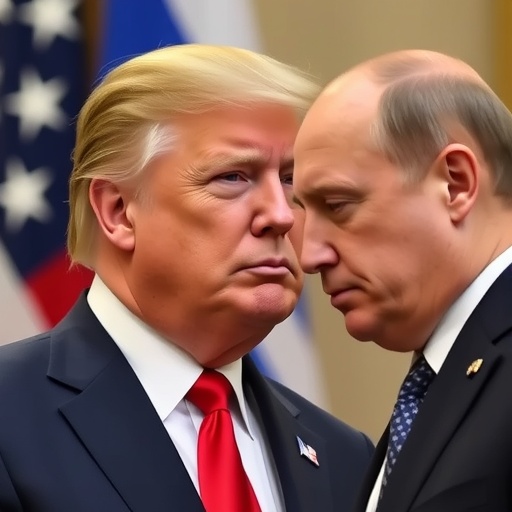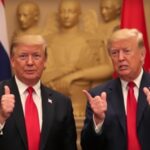US, Russia, and Ukraine Nearing Diplomatic solution to End War, Putin’s Envoy Reveals Amid Trump-Putin Summit Speculation
In a stunning development that could reshape global geopolitics, Kirill Dmitriev, Russian President Vladimir Putin’s special envoy for investment and economic cooperation, has claimed that the US, Russia, and Ukraine are “quite close to a Diplomatic solution” to halt the three-year war ravaging Eastern Europe. Speaking after high-level talks in Washington, Dmitriev’s optimistic remarks signal a potential thaw in relations, with whispers of an impending summit between US President-elect Donald Trump and Putin adding fuel to the fire of hope for peace.
The announcement comes at a pivotal moment, as the conflict—now entering its fourth year—has claimed tens of thousands of lives, displaced millions, and strained international alliances. Dmitriev’s statement, delivered during a press briefing on the sidelines of economic discussions, underscores a rare alignment among the three key players: the US, Russia, and Ukraine. While details remain scarce, the envoy hinted at progress in negotiations focusing on territorial integrity, security guarantees, and economic reconstruction.
“We are quite close to a Diplomatic solution,” Dmitriev told reporters, emphasizing the constructive nature of the Washington dialogues. “The talks have been productive, and all sides are committed to finding a path forward.” This revelation arrives just weeks before Trump’s inauguration, raising questions about how the incoming administration might pivot US foreign policy toward de-escalation.
Dmitriev’s Washington Talks Spark Hope for Breakthrough
Kirill Dmitriev, a seasoned financier and close advisor to Putin, arrived in Washington not just to discuss investments but to lay the groundwork for broader diplomatic overtures. His role as envoy has evolved since the war’s onset in 2022, blending economic diplomacy with political maneuvering. During the recent meetings, which involved US officials from the State Department and Treasury, Dmitriev reportedly pushed for eased sanctions in exchange for Russian concessions on the battlefield.
Sources familiar with the discussions, speaking on condition of anonymity, described the atmosphere as “cautiously optimistic.” Topics ranged from humanitarian corridors to post-war reconstruction aid, with the US expressing willingness to facilitate talks if Russia demonstrates goodwill. Dmitriev’s claim of proximity to a diplomatic solution aligns with reports of backchannel communications between Moscow and Kyiv, mediated by Western allies.
One key outcome from the Washington visit was a tentative agreement on prisoner exchanges, which could serve as a confidence-building measure. According to Ukrainian officials, over 10,000 prisoners of war remain in Russian custody, and any swap would be a tangible step toward de-escalation. Dmitriev praised the US for its “pragmatic approach,” subtly nodding to the shifting dynamics under the incoming Trump administration.
The envoy’s visit also highlighted Russia’s economic woes amid the war. With GDP growth stalling at around 1.5% last year due to sanctions, Dmitriev advocated for joint ventures in energy and technology as incentives for peace. “Economic cooperation can be the bridge to political resolution,” he stated, quoting figures from the World Bank that estimate Ukraine’s reconstruction costs at over $400 billion.
Trump’s Potential Influence on US-Russia-Ukraine Dynamics
At the heart of this diplomatic surge is Donald Trump, whose election victory has injected uncertainty and opportunity into the US, Russia, and Ukraine triangle. Trump has long criticized the war as a “bloodbath” and vowed to end it swiftly, perhaps within his first 100 days in office. Speculation about a Trump-Putin summit, possibly in a neutral location like Saudi Arabia or Turkey, has intensified following Dmitriev’s remarks.
Trump’s inner circle, including advisors like JD Vance and Keith Kellogg, has signaled a review of US aid to Ukraine, which totals over $175 billion since 2022. In a recent interview with Fox News, Trump reiterated, “I’m the only one who can stop this war—Russia respects strength, and we’ll negotiate from there.” This approach contrasts with the Biden administration’s staunch support for Kyiv, potentially paving the way for a more transactional diplomatic solution.
Analysts point to Trump’s past rapport with Putin as a wildcard. During his first term, the two leaders met multiple times, fostering a personal chemistry that could expedite talks. However, Ukrainian President Volodymyr Zelenskyy remains wary, insisting on NATO membership and full Russian withdrawal as non-negotiables. In a statement from Kyiv, Zelenskyy said, “Any solution must respect Ukraine’s sovereignty; we’re open to dialogue but not at the cost of our future.”
Behind the scenes, Trump’s team is reportedly consulting European allies, including Germany and France, to avoid fracturing NATO. A potential summit agenda might include demilitarization zones along the front lines, which stretch over 1,000 kilometers, and guarantees against future aggression. Economically, Trump could leverage US LNG exports to Europe as a bargaining chip, reducing reliance on Russian gas that once accounted for 40% of supplies.
Three Years of Conflict: From Invasion to Stalemate
The war between Russia and Ukraine, ignited by Moscow’s full-scale invasion on February 24, 2022, has evolved from a swift operation into a grinding attritional struggle. What began as an attempt to “denazify” and demilitarize Ukraine—terms used by Putin—has resulted in over 500,000 casualties on both sides, according to estimates from the UN and Western intelligence.
Key battles, such as the siege of Mariupol and the counteroffensive in Kharkiv, underscore the human toll. Mariupol alone saw up to 25,000 civilians killed, with satellite imagery revealing widespread destruction. Ukraine’s resilience, bolstered by Western weapons like HIMARS and Javelin missiles, has prevented a Russian victory, but at a steep price: its economy contracted by 30% in 2022, and inflation hovers at 20%.
Internationally, the conflict has redrawn alliances. The US has led sanctions that froze $300 billion in Russian central bank assets, while NATO expanded with Finland and Sweden’s accession. Russia, in turn, deepened ties with China, Iran, and North Korea, securing drones and artillery shells that prolonged the fight. A 2023 intelligence report from the CIA noted that Russian forces control about 18% of Ukrainian territory, including Crimea annexed in 2014.
Civilian impacts are profound: over 6 million Ukrainians have fled abroad, creating Europe’s largest refugee crisis since World War II. War crimes allegations, including those at Bucha and Izium, have led to ICC arrest warrants for Putin and his officials. Amid this backdrop, Dmitriev’s push for a diplomatic solution revives memories of earlier failed ceasefires, like the Minsk agreements of 2014-2015, which collapsed amid mutual distrust.
Skeptics Voice Concerns Over Russia’s True Intentions
While Dmitriev’s words offer a glimmer of hope, experts and diplomats urge caution. Michael Carpenter, a former US National Security Council official, warned in a recent op-ed for Foreign Affairs that “Russia’s history of bad-faith negotiations makes any claim of closeness suspect.” He cited Putin’s 2024 demands for Ukraine’s neutrality and territorial concessions as potential deal-breakers.
Ukrainian analysts echo this skepticism. Olha Aivazovska, head of the Civil Network OPORA, told Reuters, “We’ve heard promises before; without ironclad security, it’s just another stall tactic.” Public opinion in Ukraine remains divided: a September 2024 poll by the Kyiv International Institute of Sociology showed 60% of Ukrainians oppose territorial compromises, even for peace.
On the Russian side, state media portrays the war as defensive against NATO expansion, with Putin framing any diplomatic solution as a victory. Hawkish voices in Moscow, including Dmitry Medvedev, have dismissed talks unless Ukraine capitulates. Economically, Russia’s pivot to parallel imports has mitigated some sanctions, but military spending—now 6% of GDP—strains resources.
International observers, such as the International Crisis Group, recommend multilateral involvement, perhaps through the UN or OSCE, to verify any agreements. Challenges include enforcement mechanisms: past deals lacked teeth, leading to renewed fighting. With winter approaching, energy infrastructure attacks could escalate, testing the resolve for dialogue.
In Washington, bipartisan concerns linger. Senate Foreign Relations Committee Chair Ben Cardin emphasized, “The US must ensure any deal upholds democratic values and deters aggression.” Trump’s unpredictable style adds another layer, as his “America First” doctrine might prioritize domestic issues over prolonged foreign entanglements.
Path Forward: Summit Preparations and Global Repercussions
As preparations for a possible Trump-Putin summit accelerate, the world watches closely. Logistical details—venue, timing, and agenda—are under discussion, with early February floated as a target post-inauguration. Success could unlock frozen assets for Ukraine’s rebuild and normalize trade, potentially boosting global markets; failure risks escalation, including nuclear saber-rattling from Moscow.
For Ukraine, a diplomatic solution means reclaiming normalcy: reopening ports like Odesa, vital for grain exports that feed 400 million people worldwide, and integrating into the EU, where accession talks advanced in 2024. Russia seeks sanction relief to stabilize its ruble, which has fluctuated wildly since 2022.
The US stands at a crossroads, balancing alliances with strategic interests. Trump’s involvement could redefine transatlantic relations, encouraging Europe to shoulder more defense burdens. Broader implications extend to the Middle East and Asia, where a resolved conflict might redirect focus to tensions with China.
Ultimately, the coming months will test commitments. If Dmitriev’s optimism proves founded, it could mark the war’s endgame; otherwise, the US, Russia, and Ukraine face prolonged uncertainty. Stakeholders from Berlin to Beijing are positioning accordingly, underscoring the conflict’s global stakes.










